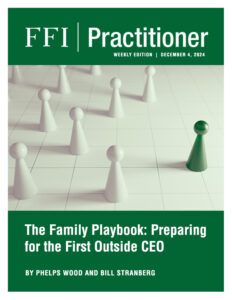
View this edition in our enhanced digital edition format with supporting visual insight and information.
In this week’s edition of FFI Practitioner, Phelps Wood and Bill Stranberg highlight strategies for family enterprise advisors to consider when client families first bring a non-family executive into the business as CEO.
The decision to bring a non-family executive (NFE) into the role of CEO in a family business marks a pivotal point in its lifecycle. It requires a carefully prepared platform that ensures alignment between the family’s vision and governance structure, and the executive’s authority and accountability. This preparation is crucial not just for the NFE’s success but also to maintain the integrity and continuity of the family business.
Families hire non-family executives for various reasons. Some are interim leaders brought in to manage the business during generational transitions, while others are CEOs tasked with preparing the business for sale. In some instances, families step away from day-to-day management entirely, selecting an NFE to lead the business operations in alignment with the family’s vision and values. Regardless of the motivation behind hiring a non-family CEO, success depends on a clearly defined strategy, strong support from family owners and business executives, and unambiguous authority over decision-making.
Strategic Planning
This article defines a CEO as a fiduciary employee that executes strategy on behalf of the owners. With this definition in mind, the first pillar of CEO selection is often determining a client’s business strategy. Developing a corporate strategy can be a naturally complicated process, but below are three main components to consider:
- Core Values: Thorough consideration and documentation of the family’s core values not only determine the character of the family’s company but also establish the basis for how and why decisions are or are not made.
- Vision: The owners’ vision sets the direction for the entire business, identifying long-term goals in line with their values. Be it aggressive growth with an aim toward an exit or sustaining a multigenerational business, the vision defines where the family enterprise is going.
- Year Five Goal: It is the CEO’s job to achieve the corporate goals articulated by the owners and board. The Year Five Goal sets a long-term milestone that the CEO is assigned to meet. By aligning on a Year Five Goal, clients unlock the ability to measure their CEO’s performance.
By addressing these three components within a corporate strategy, a family can more effectively develop a description of the CEO role that aligns with their core values, corporate vision, and long-term goals. These three components can be translated into a document that outlines the experience and character traits as well as the goals the NFE will need to achieve in order to succeed in the family business. When properly crafted, this document is a position profile and road map that not only accurately lays out the role, but also how the executive performance will be measured.
Preparing Family & Employees
In most family businesses, the Chief Executive role turns over quite rarely when compared to other ownership models.1 This is often due to a combination of factors including generational leadership succession, stronger emotional investment in the role, less external pressure for leadership changes and different, or non-existent, performance evaluation metrics. As an example, the authors have recently worked with a fourth-generation business in Chicago in which the incumbent CEO has held the role for an astounding 56 years.
When a long tenured chief executive plans their exit, expect family and non-family employees to aspire to fill the role. This is a delicate situation and, if handled incorrectly, may result in conflict or attrition. Often, the best way to handle internal interest in the CEO role is a policy of transparency and fairness. Even with the best laid plans, expect and prepare for bumps in the road. The authors suggest preparing clients with the following to help ensure a more orderly CEO transition:
- Transparency: Be clear about intentions from the outset. The selection of a CEO is not a personal appointment but a strategic one. Executive leadership should not be considered a birthright or inheritance. Because so many people are dependent on the success of the business, the chief executive has the responsibility of ensuring that the business provides for all stakeholders that depend upon it, including employees, family owners and non-owners, vendors, and the community. Selecting the next CEO is a process of determining who is best qualified to shoulder that burden.
- Fairness: To help facilitate an effective process, keep the focus on the business and on the family’s goals by concentrating on values, vision, and strategy. A position description with specific criteria can help to minimize any perceived bias and enables the board to select the candidate that is best suited for the business. To further remove any perceptions of bias, consider working with an outside firm that can facilitate a fair and objective process.
- Bumps in the Road: Candidates rarely have much visibility into the personal dynamics and relationships ahead of joining the business. Integration, acceptance, and success can be greatly improved by involving relevant stakeholders (including both family and key employees) in the discussions and preparation necessary for a CEO transition. Inevitably challenges will arise that cannot be identified ahead of time, so prepare these key stakeholders to deal with them honestly and openly.
Governance
The operational dynamics of decision-making authority and the CEO’s interaction with the family and the organization require thoughtful planning, including the following:
- Roles and Responsibilities: It is essential to establish clear decision-making boundaries and to understand the impact of introducing an NFE on family dynamics and business operations. In addition to the criteria for the NFE, the roles of the owners, board, and other executives may need further clarification to avoid conflict and confusion.
- Delegation of Authority: Families who choose to hire a non-family CEO need to clarify what types of decisions the CEO can make with and without board and owner approval. Bringing clarity to decision authority provides transparency and a process to business decision-making. Without a clear decision-making process, it is much more likely that problems will arise that may undercut the NFE’s ability to perform or may result in misalignment of business and family goals.
- Board / Organizational Structure for Success: When a family hires a non-family member to run its company, they also need to determine how the family, as business owners, will govern the business and manage the CEO. Great executive talent will demand a coherent approach to governance that provides a framework in which the non-family CEO can succeed and in which their interests are protected.
Governance is an umbrella term for a broad set of functions that allow a family ownership group to manage their business and broader affairs. While best practices call for a coordinated system of governance among the owners, family, and business, the vast majority of family companies that the authors come across are operating systems with much less definition or structure.
A non-family CEO ultimately reports to the board of directors. Therefore, governance plays a crucial role in determining the type of executives who will thrive within the family business. Generally, the authors’ experience has found that the more mature the governance model, the wider the appeal of the business to top talent. At a minimum, families must provide clear expectations for success and maintain consistency in both ownership vision and management practices to ensure success with non-family executives.
Summary
Without a detailed strategic plan, support from family and business members, and clear responsibilities and authority, no CEO can succeed. To attract the best candidates and to set up both the CEO and the business for success, it is beneficial for advisors to family businesses to do the following first:
- Ensure that the values, vision, and mission of both the family and business are clear and aligned.
- Maintain harmony and reduce conflict by creating a transparent, inclusive, and fair process with family and business members to prepare for organizational change.
- Be certain that a governance framework exists that establishes clear decision-making authority, support for the CEO, and appropriate boundaries between family and business.
Hiring a non-family executive as CEO is a significant step that requires careful preparation, clear strategic alignment, and thoughtful consideration of both the family’s and the business’s future. By focusing on governance, talent planning, and creating a supportive environment for the NFE, advisors can help family businesses navigate this transition successfully, ensuring long-term growth and sustainability.
Reference
1 Stalk, George, Jr., and Henry Foley. “Avoid the Traps that Can Destroy Family Businesses.” Harvard Business Review (January – February 2012). https://hbr.org/2012/01/avoid-the-traps-that-can-destroy-family-businesses.
About the Contributors

Phelps Wood is an advisor to enterprising families and the founding Principal of Tres Arcos Partners. Phelps draws from his background of growing up in a family business and running a multi-family enterprise to help his clients navigate leadership and ownership transitions, improve governance and strengthen family relationships. He can be reached at phelps@tresarcospartners.com.

Bill Stranberg is a second-generation member of Stranberg Resource Group (SRG), a family-owned executive search and leadership consulting firm. Bill is an expert in helping families prepare for and recruit top talent to achieve their business goals. He can be reached at bill@stranberg.com.

View this edition in our enhanced digital edition format with supporting visual insight and information.





